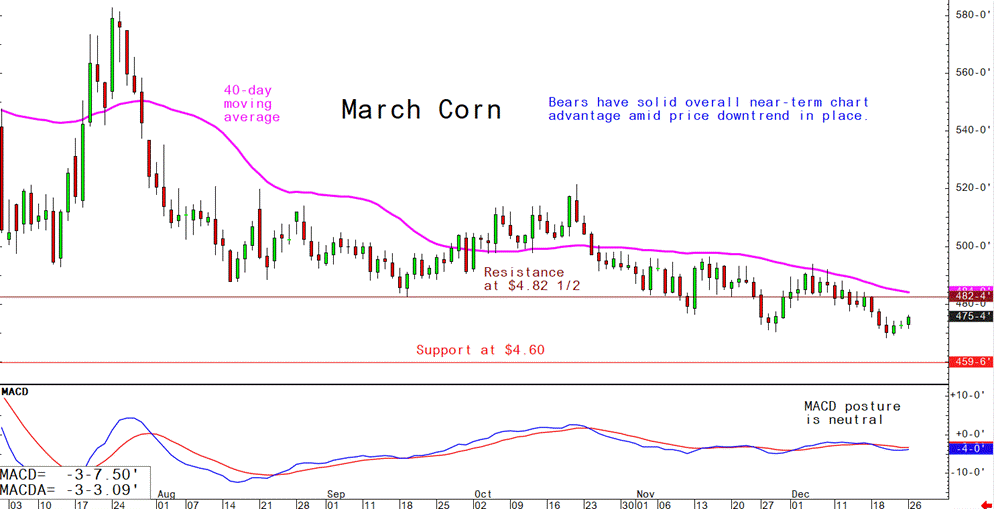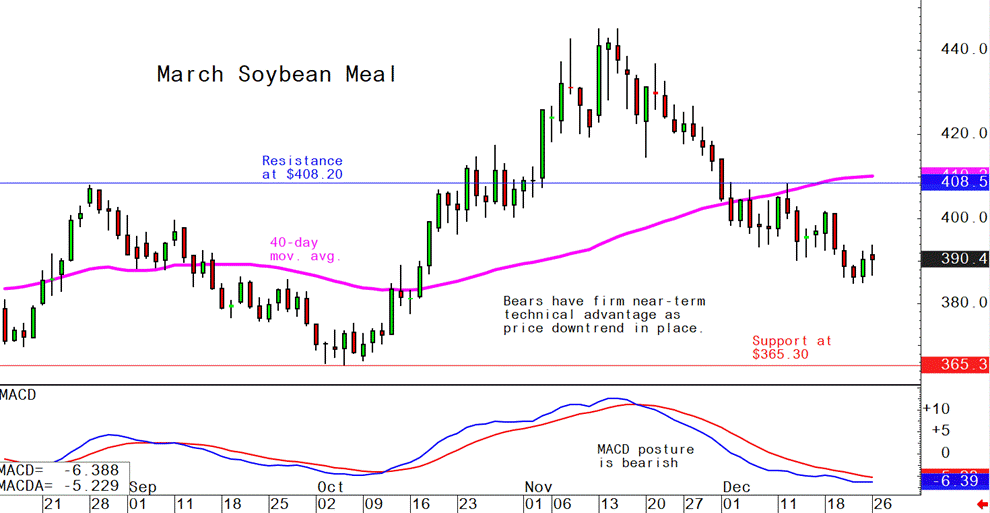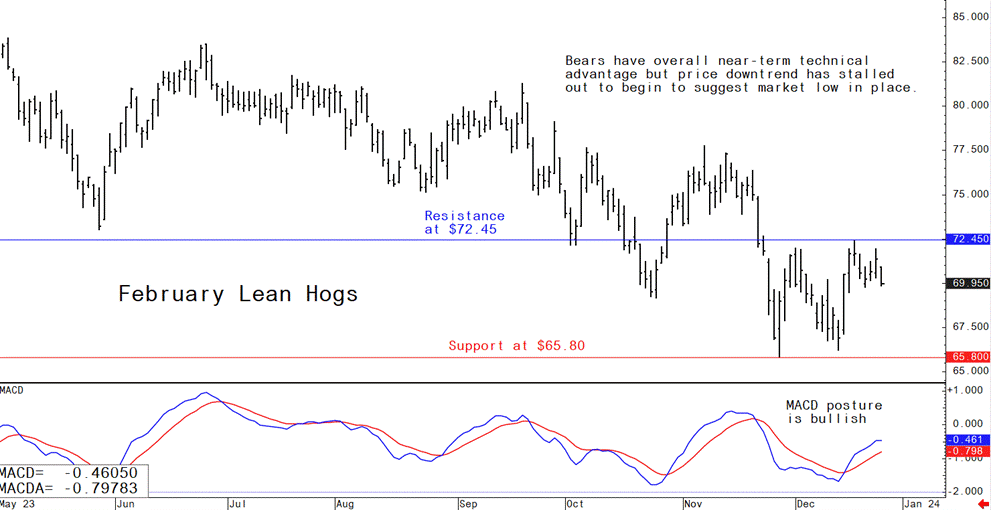



Pig outlook — Lean hog futures bulls working on a price bottom
Livestock analyst Jim Wyckoff shares global pig newsLean hog futures prices are still trading in a sideways and choppy fashion at lower levels. However, recent price action begins to suggest a market bottom is in place, including the specter of a bullish double-bottom reversal pattern forming on the daily bar chart. Last Friday’s bearish Hogs & Pigs report will limit the upside in hog futures early this week.
The latest CME lean hog index fell another 44 cents to $66.25 (as of Dec. 21)--a seasonal low. Some hog market bulls are still confident about the short-term hog outlook amid firmer fresh pork prices and good movement. In recent years the cash hog market has shown a tendency to dip to annual lows between Christmas and New Years holidays.
USDA hogs and pigs report bearish
USDA’s Hogs & Pigs Report last Friday estimated the U.S. hog herd at 74.971 million head as of Dec. 1, up 15,000 head from year-ago, whereas traders expected a 481,000-head decline based on the average pre-report estimate. The market hog inventory increased 221,000 head (0.3%) from year-ago, while the breeding herd declined 205,000 head (3.3%). The data was negative compared to pre-report expectations, though it wasn’t overly bearish. However, the sharp revisions to past data will increase trader skepticism toward these numbers and may cause them to believe USDA’s sampling methodology is consistently undercounting hog numbers.
USMEF says pork exports to Japan fell in 2023
Pork exports to Japan are trending lower in 2023, including a 15% decline in October to 24,080 mt, according to data released by USDA and compiled by the US Meat Export Federation (USMEF). For January through October, exports to Japan fell 6% from a year ago to 288,447 mt, valued at $1.17 billion (down 7%).
USDA cold storage report: US pork stocks decline less than normal
USDA’s Cold Storage Report showed pork inventories totaled 416.1 million lbs. at the end of November, down 21.8 million lbs. (5.0%) from October. The five-year average was a 45.2-million-lb. decline during the month. Pork stocks dropped 35.5 million lbs. (7.9%) from year-ago and were 55.1 million lbs. (11.7%) under the five-year average. Beef stocks totaled 454.7 million lbs., up 9.0 million lbs. (2.0%) from October. The five-year average was a 10.4-million-lb. increase during the month. Beef stocks fell 68.6 million lbs. (13.1%) from year-ago and were 49.0 million lbs. (9.7%) less than the five-year average.
Brazil pig production expected to continue growth in 2024
Brazil closed 2023 with a positive balance in swine production and exports. The year 2024 should maintain the growth line, according to projections by the Brazilian Animal Protein Association (ABPA), presented at a hybrid press conference in São Paulo. Brazilian pork production is expected to show growth of up to 2.3% compared to last year, with production of up to 5.1 million tons. Exports are expected to reach up to 1.22 million tons, an increase of up to 8.9% compared to 2022. For 2024, an increase of up to 1% is projected compared to 2023, with an estimated production of up to 5.15 million tons. In exports, the increase should also be confirmed, with an increase of up to 6.6% compared to this year, with shipments of up to 1.3 million tons. The availability of products on the domestic market is expected to remain stable in 2023 and 2024, at around 3.8 million tons. Stability in per capita consumption is also projected over the two years, with around 18 kilos per inhabitant.
“There are good prospects for an increase in exports from the opening of new markets and expansion into already consolidated destinations, also due to the slowdown in shipments from important competitors, such as the European Union and Canada," said ABPA marketing director Luis Rua. "On the other hand, in the domestic market, a new level of consumption is being consolidated, around 18 kilos per inhabitant per year, well above what was seen until a few years ago."
Massachusetts seeks dismissal of Q3 animal welfare law challenge
The state of Massachusetts has requested the dismissal of a lawsuit challenging its Question 3 (Q3) animal welfare law. They argue that Triumph Foods' complaint lacks merit as the company cannot demonstrate harm resulting from the related regulations. The Q3 standards, which regulate pork sold in Massachusetts, came into effect on Aug. 24. Triumph Foods claims that Q3 violates the Commerce Clause and other provisions of the U.S. Constitution.
U.S. District Judge William Young previously rejected most of the complaint in October but maintained a claim that the law discriminates against out-of-state producers. Massachusetts, in its motion to dismiss on Dec. 18, pointed out that all Triumph products are sold through Seaboard Foods under a 2004 agreement. State officials argued that Triumph has not proven that Seaboard cannot continue to meet its obligations under the agreement despite Massachusetts' policies. Therefore, they contend that the entire amended complaint should be dismissed for lack of jurisdiction.
The next week’s likely high-low price trading ranges:
February lean hog futures--$68.00 to $74.00 and with a sideways-higher bias
March soybean meal futures--$365.30 to $405.00, and with a sideways-lower bias
March corn futures--$4.60 to $4.85 and a sideways-lower bias
Latest analytical daily charts lean hog, soybean meal and corn futures












